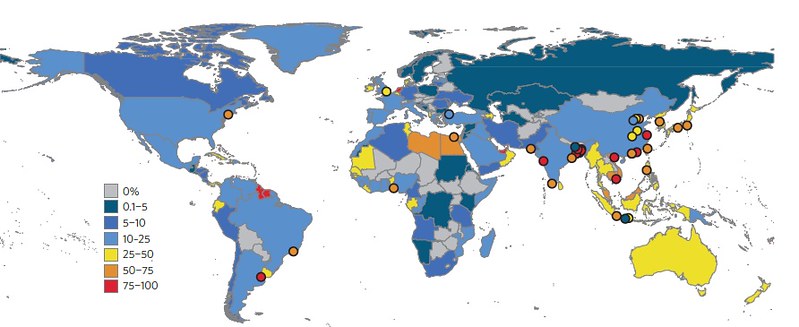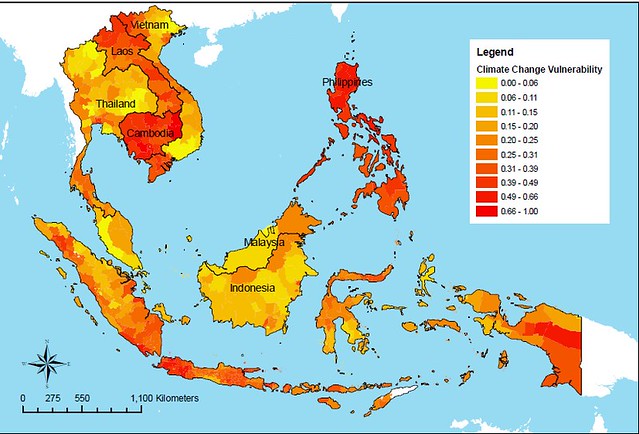An academic article just released in the journal Nature Climate Change and reported worldwide further confirms we are entering a period of human-influenced climate change which will affect the carbon dioxide in the atmosphere of this planet for tens if not hundreds or thousands of years. Put simply, melting sea ice in the Arctic and Antarctic does not readily refreeze. The result of years of study by multiple researchers, is a map that plots the consequences of long-term global warming and looks like this:

Figure 1: Long-term effects of global warming on populated areas via rising sea levels
In this long-term scenario, 25-75% of ASEAN will be lost to rising sea levels, including all coastal cities. This is not an alarmist perspective. This is the outlook that the US intelligence community accepts – the one lawmakers are briefed on, in more detail, by the CIA and the Pentagon in private, while some, mainly those in the Republican Party with close ties to the fossil fuel industry, reject the same perspective in public. As the 2012 National Intelligence Council’s (NIC) 2012 report Global Trends 2030: Alternative Worlds, puts it:
With… melting, scientists now estimate that sea-level rise will be 1 meter or more by the end of the century and the rate will increase, making effective adaptation more difficult to achieve. Even modest sea-level rises, when coupled with potential storm surges from more intense storms and subsidence of delta lands, will have a significant adverse impact on coastal regions and Pacific small-island states.
The side effects on areas like ASEAN will be diverse and catastrophic. They include the mass evacuation of coastal cities, i.e., internal migration from increasingly flooded coastal areas. Again, the NIC report is specific on this point: “Flood-driven migration will wipe out homes and infrastructures and significantly increase the perception of the risk of staying.”
Within ASEAN, a 2009, more detailed study commissioned by Canadian and Swedish agencies, the Climate Change Vulnerability Mapping for Southeast Asia report, provides a composite picture of the effects not just of sea rise but of the combined effects of rising sea levels and climatic effects from increased greenhouse gases in the atmosphere:

Figure 2: Composite index of effects of climate change of ASEAN
This composite picture, which shows the collapse of human systems, especially in the Philippines, Laos, and Cambodia, includes the effects of worsening and more frequent tropical cyclones, floods, drought, landslides, and rising sea levels. At the district level, the following table shows the number of highly stressed provinces, partially destroyed, and highly vulnerable in each ASEAN country.
|
Country |
Highly Stressed Provinces |
Stressed Provinces |
Vulnerable Provinces |
|
Cambodia |
3 (Mondol Kiri, Rotanokiri, Kampong Spoe) |
7 |
7 |
|
Indonesia |
7 (Central, North, South, East, West Jakarta, Kota Bandung, Kota Surabaya |
18 |
52 |
|
Lao PDR |
|
2 (Phongsali, Houaphan) |
6 |
|
Malaysia |
|
|
3 (Sabah, Kelantan, Pulau Pinang) |
|
Philippines |
1 (National Capital Region) |
6 |
7 |
|
Thailand |
|
1 (Bangkok) |
4 (Samut Prakan, Nonthaburi, Trang, Samut Sakhon) |
|
Vietnam |
|
2 (Lai Chau, Dong Thap) |
9 |
Table: Cities and districts already highly stressed and, in case of coastal provinces, potentially incompatible with human civilization within this century (due to sea rise)
It is very probably that those coastal provinces in the Highly Stressed and Stressed provinces will be incompatible with human habitation by the end of this century due to a minimum 1-meter sea level rise. Again, this picture of the collapse of human systems due to the combined effects of climate change is one supported by the US national intelligence community, which predicts increasing food and water shortages:
Climate change analysis suggests that the severity of existing weather patterns will intensify, with wet areas getting wetter and dry and arid areas becoming more so… Many countries probably won’t have the wherewithal to avoid food and water shortages without massive help from outside.
In the case of the Mekong basin countries, the collapse of the Mekong River is expected to cause serious problems for agriculture and will present a picture of persistent droughts driven by climate change:
Flows in the… Mekong river basins have been diminished by droughts that have persisted during the past decade. Although weather patterns in these regions are dominated by natural variability, these persistent droughts are consistent with the expected effects of warming from increased greenhouse gas concentrations in the atmosphere.
However, in Thailand, one of the systems most vulnerable to drought is actually the Chao Praya River, though the South will also be heavily affected, as can be seen in the Southeast Asian mapping report, which relies on historical data.

Figure 3: Drought frequency (event per year from 1980-2000)
As the NIC report notes, this historical evidence is a clear indicator of the breakdown of the normal climate, a situation which will only worsen over the twenty years until 2030 covered by the intelligence community’s report:
Empirical evidence alone — without reference to climate models — indicates that a general warming trend is affecting weather and ecosystems, causing increasing impacts on humans. Recent weather has been characterized by an increase in the frequency of extreme weather events — floods, droughts, tornadoes, glacial lake outbreaks, extreme coastal high-water levels, heat waves, etc. — and this pattern almost certainly will continue during the next 20 years.
As can be seen from Figure 3, above, Bangkok is already severely affected by drought. The collapsing of human systems, such as coastal cities like Bangkok, will continue beyond 2030 and will result in the abandonment of cities like Jakarta and Bangkok.
The recent climate change conference in Paris, 2015 United Nations Climate Change Conference, COP 21, will likely not prevent a picture of increasing global temperatures beyond the fall back 2030 target of 2C since industrialisation, very much beyond the optimal target of 1.5C. The latter – the only scenario in which Bangkok may survive – is a goal which will likely require zero global warming emissions being implemented between 2030 and 2050.
The low likelihood of reaching the 1.5C and 2C goals is because no-one knows how to implement zero net emissions. Moreover, there is no detailed timetable in the COP 21 agreement, nor are there country-specific goals which are rationally supported other than by vague notions of ‘technology transfer’ and ‘clean coal technology’. Moreover, there are no enforcement mechanisms. In fact, the COP21 Paris Agreement has not even been ratified yet – it will open for ratification in April 2016 and will require 55% of countries producing 55% of greenhouse gas emissions to ratify it before it comes into effect.
Unfortunately, the US intelligence community’s NIC report provides a more realistic scenario:
The present emissions pathway is leading to a doubling of greenhouse gases by mid-century. Based on a better understanding of climate sensitivity and emissions, this concentration will lead to approximately 2°C warming by mid-century. Under the present emissions pathway, 6°C is more likely than 3°C by the end of the century, and will lead to even more significant impacts. By 2030 the emissions trajectory will be cast, determining this century’s climate outcome.
The only way to avoid this situation – one in which tens of millions of premature deaths every year will occur, especially in Africa and South Asia – is a complete reassessment of the causes and means of reducing global greenhouse gases.
As the NIC report notes, “Indian analysts talked about the need to think about a “new extended commons” which would include cyberspace, outer space, and maritime space.” The obvious extension of this paradigm is to see the climate as part of this extended commons – i.e., no longer as a natural system but as a human system - and develop a political solution, which the next column will explore.
Prachatai English is an independent, non-profit news outlet committed to covering underreported issues in Thailand, especially about democratization and human rights, despite pressure from the authorities. Your support will ensure that we stay a professional media source and be able to meet the challenges and deliver in-depth reporting.
• Simple steps to support Prachatai English
1. Bank transfer to account “โครงการหนังสือพิมพ์อินเทอร์เน็ต ประชาไท” or “Prachatai Online Newspaper” 091-0-21689-4, Krungthai Bank
2. Or, Transfer money via Paypal, to e-mail address: [email protected], please leave a comment on the transaction as “For Prachatai English”
